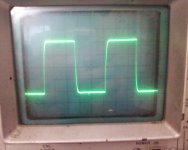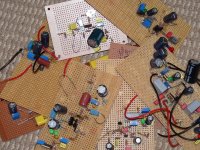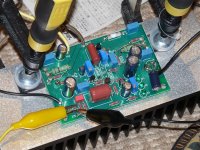here the pictures of a 20 Khz square wave without a input filter and one with input filter and a sweep from 10 to 22 Khz, there is no overshoot whatsoever, and it sounds very clean with a deep black deepness.
Attachments
Nice results, but what's the relevance to an amp developed in this thread (since you show no schematic and some tubes are to be seen)?
Nice results, but what's the relevance to an amp developed in this thread (since you show no schematic and some tubes are to be seen)?
It is a little offtopic I now, I am busy with a design taken from this thread, I have posted the schematic already, who is nice performing with verticals, there is already a update here but not posted yet,.. but I do hybrides as mean task so why not post it, I hope that more depletion mosfets are coming, she are promissing speacial if made for audio...
This design is specifically aimed at driving Lateral output mosFETs.
Toshiba are vertical mosFETs.
If you are capable you can re-design to suit the Toshibas and post your results in a new thread.
post1555 suggests opening his own thread.what's the relevance to an amp developed in this thread
A monumental decision...
All,
Firstly, separation, sophistication, clarity and soundstage are all important. But in my books if you're not tapping your feet then the rest doesn't matter.
Today I have decided to stop chasing perfection. I was just talking to Hugh on Skype and somewhere through the conversation I had an epiphany.
As you are aware, fetzilla is capable of some pretty amazing overshoot, not like the beautiful square waves just posted. However, it does not seem to oscillate and is quite stable. I am a scientist by trade and love symmetry, numbers and order by definition. The overshoot eats away at me every day and i have been trying to get rid of it since the outset.
The truth of the matter is, to me at least, fetzilla sounds absolutely fantastic even with the overshoot. Every modification I do to try and make the square wave performance nicer has an adverse affect on the sound, except perhaps a little miller capacitance.
I'm going to let my ears triumph over my scientific brain, which just hates to see a non-square square wave, and just accept it for what it is. It sounds wonderful with no compensation or other retardant. I'm going to leave it that way, put it in an enclosure and enjoy it.
With no compensation, in its raw form, fetzilla is capable of rattling the windows with bass and provides amazing punch. With a good recording it will produce crystal clear treble with beautiful cymbal clashes. All of this is provided with an energy I've never experienced in an amplifier, and a sense of life that is just wonderful.
So, I'm gonna leave it.
Now, one exception to my findings would be if all you listen to is vocals or pure acoustic recordings. If this is the case, a little phase lead compensation will add some refinement. however, I would only suggest this if you really don't listen to anything else 🙂
Now, let the flames begin! Oh btw, this is all in my opinion, with my speakers in my room. Don't take my word for it, try it yourself!
All,
Firstly, separation, sophistication, clarity and soundstage are all important. But in my books if you're not tapping your feet then the rest doesn't matter.
Today I have decided to stop chasing perfection. I was just talking to Hugh on Skype and somewhere through the conversation I had an epiphany.
As you are aware, fetzilla is capable of some pretty amazing overshoot, not like the beautiful square waves just posted. However, it does not seem to oscillate and is quite stable. I am a scientist by trade and love symmetry, numbers and order by definition. The overshoot eats away at me every day and i have been trying to get rid of it since the outset.
The truth of the matter is, to me at least, fetzilla sounds absolutely fantastic even with the overshoot. Every modification I do to try and make the square wave performance nicer has an adverse affect on the sound, except perhaps a little miller capacitance.
I'm going to let my ears triumph over my scientific brain, which just hates to see a non-square square wave, and just accept it for what it is. It sounds wonderful with no compensation or other retardant. I'm going to leave it that way, put it in an enclosure and enjoy it.
With no compensation, in its raw form, fetzilla is capable of rattling the windows with bass and provides amazing punch. With a good recording it will produce crystal clear treble with beautiful cymbal clashes. All of this is provided with an energy I've never experienced in an amplifier, and a sense of life that is just wonderful.
So, I'm gonna leave it.
Now, one exception to my findings would be if all you listen to is vocals or pure acoustic recordings. If this is the case, a little phase lead compensation will add some refinement. however, I would only suggest this if you really don't listen to anything else 🙂
Now, let the flames begin! Oh btw, this is all in my opinion, with my speakers in my room. Don't take my word for it, try it yourself!
post1555 suggests opening his own thread.
I can do, but where? I do also hybrides and there is not a place for that.
O jahh, here is the schematic what I did use for the scope pictures..
I will move to a new thread, you are right.
Attachments
excellent Greg,
I couldn't agree more, amps are for listening and enjoyment. Scope performance is academic in comparison - just a check against disaster.
and that overshoot you see on sq waves will probably never get excited with real music.
I'm just gonna begin my square wave investigation and I'm sure it will be interesting but I'm with you 100% on going with your ears and your personal preference. I wouldn't do anything else.
I couldn't agree more, amps are for listening and enjoyment. Scope performance is academic in comparison - just a check against disaster.
and that overshoot you see on sq waves will probably never get excited with real music.
I'm just gonna begin my square wave investigation and I'm sure it will be interesting but I'm with you 100% on going with your ears and your personal preference. I wouldn't do anything else.
Hey, there's one small improvement possible in the bootstrap; take the bootstrap from the P-MOSFET's source instead of the middle of the .1R resistors. This will improve current regulation of the Jfet. Dunno if it would change the sound.
- keantoken
- keantoken
SWF, for groundplane prototyping why not just use veroboard and rest it on top of a blank PCB covered in masking tape?
- keantoken
- keantoken
Kean,
The PCB was never meant to be a prototype! It was meant to be my final version.
I left facilities for all sorts of compensation and filters, but now that I have decided I don't want them I think I'll make something more compact. Nice idea with the masking tape though.
The PCB was never meant to be a prototype! It was meant to be my final version.
I left facilities for all sorts of compensation and filters, but now that I have decided I don't want them I think I'll make something more compact. Nice idea with the masking tape though.
For my prototypes I want to use a PCB covered in masking tape, and then cut out parts of the tape to use as ground connections. This way I can solder the components and wiring very close to the plane. I can even build the same prototype on both sides of the board, for a stereo prototype. However I suspect that having two ground planes right next to each other could cancel the ground plane specific effect of currents "following the path of least inductance". No one has bothered to try and confirm or deny this to me however.
- keantoken
- keantoken
Hmm,
Was just playing around again, and it turns out 330pf to 500pf of miller capacitance will solve my overshoot problem. Didn't have much of a listen as it is late here, but my hopes aren't very high. This is an order of magnitude greater than I have tried before. Any thoughts on whether this is an obscene amount compared to most amplifiers?
Was just playing around again, and it turns out 330pf to 500pf of miller capacitance will solve my overshoot problem. Didn't have much of a listen as it is late here, but my hopes aren't very high. This is an order of magnitude greater than I have tried before. Any thoughts on whether this is an obscene amount compared to most amplifiers?
This is a VERY fast amp, and as a rule the faster the amp, the larger the compensation cap needed.
- keantoken
- keantoken
A while ago you were forgetting overshoot and celebrating the great sound of your amp.
What happened ?
I guess your ears will decide if it's obscene
but beings you asked, then yes, I think it is obscene ! 🙂
What happened ?
I guess your ears will decide if it's obscene
but beings you asked, then yes, I think it is obscene ! 🙂
Haha,
Yes true! The only thing I am nervous about is I have been tesing with very short leads and I worry about what will happen when I finally get it into the lounge room and have 3m cables.
But yes, you are right. I fiddled with it this morning and all of last night, with both phase lead and lag up to 330pf, and every combination in between. 330pf does tame it, but the life just disappears and it begins to sound like any other amplifier. I dropped the degeneration in the vas to see if that helped get some life back too.
I have to say, my speakers are very flat and rarely sound good, so it is possible I am looking for some artificial life for my music by using an amplifier that is slightly unstable.
As long as I can get away with it in my final listening position I will be using no compensation. I will try some stability tests with 3m leads tonight.
Oh, one more thing I have found.
I am running only 6mA in the vas using the zvp3310a and like the sound. This creates a very asymmetric square wave with a fast rise time and slower (though still 10x faster than audio) fall time. I think this strong asymmetry may increase the 2nd harmonic distortion and perhaps is why I like the sound so much with this little MOSFET.
Yes true! The only thing I am nervous about is I have been tesing with very short leads and I worry about what will happen when I finally get it into the lounge room and have 3m cables.
But yes, you are right. I fiddled with it this morning and all of last night, with both phase lead and lag up to 330pf, and every combination in between. 330pf does tame it, but the life just disappears and it begins to sound like any other amplifier. I dropped the degeneration in the vas to see if that helped get some life back too.
I have to say, my speakers are very flat and rarely sound good, so it is possible I am looking for some artificial life for my music by using an amplifier that is slightly unstable.
As long as I can get away with it in my final listening position I will be using no compensation. I will try some stability tests with 3m leads tonight.
Oh, one more thing I have found.
I am running only 6mA in the vas using the zvp3310a and like the sound. This creates a very asymmetric square wave with a fast rise time and slower (though still 10x faster than audio) fall time. I think this strong asymmetry may increase the 2nd harmonic distortion and perhaps is why I like the sound so much with this little MOSFET.
- Status
- Not open for further replies.
- Home
- Amplifiers
- Solid State
- JFET input, MOSFET VAS, LATERAL output = Perfect!!




